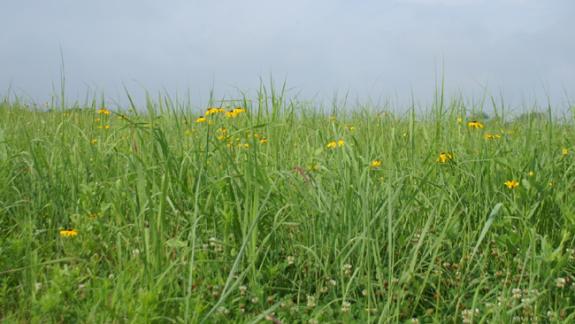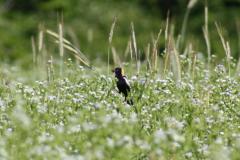Grassland Project
Conserve Wildlife Foundation has partnered with several other organizations to protect, create, and manage grasslands in New Jersey.
 A native grass stand springs to life. © MacKenzie Hall
A native grass stand springs to life. © MacKenzie Hall
The fastest vanishing landscapes in New Jersey are our agricultural ones, a few thousand acres of which are gobbled up every year by development. Disappearing hand-in-hand with them are a group of birds that depend on large, interconnected grasslands. These birds include the vesper sparrow, eastern meadowlark, American kestrel, bobolink, northern bobwhite quail, grasshopper sparrow, upland sandpiper, and several others, some of whose numbers in New Jersey have been cut in half over just the last few decades. Their future here - and elsewhere - depends on our ability to preserve and properly manage large areas of open land.
 Zoom+ Bobolink in a field being restored under the Landowner Incentive Program (LIP). With LIP, mowing is delayed each year until the end of the birds' nesting season. © MacKenzie Hall
Zoom+ Bobolink in a field being restored under the Landowner Incentive Program (LIP). With LIP, mowing is delayed each year until the end of the birds' nesting season. © MacKenzie Hall
In 2005, the Conserve Wildlife Foundation partnered with the NJ Endangered and Nongame Species Program, US Fish and Wildlife Service, Natural Resources Conservation Service, NJ Audubon Society, and others in a state-wide effort to protect, create, and manage grasslands. The Foundation works directly with farmers and other land managers to align their goals with good habitat management. We help to enroll them in incentive programs and guide them through the technical aspects of restoration.
Most grassland birds nest on the ground, so their nests, eggs, and young are easily destroyed by mowing during the breeding season. The simplest way to benefit these birds is to avoid mowing fields from April to late July. Going a step further, crop land and conventional grass fields can be converted to a more wildlife friendly, native cover: warm-season grasses like big bluestem, little bluestem, Indian grass, and switchgrass. These grasses grow in “bunches,” providing birds with excellent nesting cover within the tufts of grass and with open foraging space between them. And because they're adapted to our region’s soils and weather, these grasses don’t need to be fertilized, limed, or irrigated.
 Zoom+ Patricia Hilton seeding native warm-season grasses at her farm in Hunterdon County (June 2010). MacKenzie Hall
Zoom+ Patricia Hilton seeding native warm-season grasses at her farm in Hunterdon County (June 2010). MacKenzie Hall
Native “warm-season” grasses are so named because they mature during the hot summer months, when the more common (and non-native) lawn, hay, and pasture grasses are stressed into dormancy. This makes warm-season grasses perfect for summer grazing and later cutting. They're also highly digestible to livestock and have good protein content when harvested at the right time. Other uses for warm-season grasses include mulch, bedding, eco-tourism, and game bird habitat. A few NJ businesses (most notably Plainview Growers in Warren County) are now pelletizing the dry grass material and burning it as a low-cost and carbon-neutral biofuel to heat greenhouses, barns, and other buildings.
Native pollinators like butterflies and bees - so important to our environment and food supply - thrive in grasslands as well. Reptiles like the eastern box turtle bask in sunny fields and may use them for nesting. Field mice, snakes, turkeys, insects, bats, and hawks are just a handful of other animals that benefit from balanced grassland habitats.
Additional Resources:
- Wildlife Habitat Incentives Program (administered by USDA's Natural Resources Conservation Service)
- State Acres for Wildlife Enhancement (administered by USDA's Farm Service Agency) - Contact your local office
- Landowner Incentive Program (administered by NJ's Endangered and Nongame Species Program) - NO LONGER FUNDED
- Grassland Reserve Program (administered by USDA)
- Partners for Fish and Wildlife (administered by US Fish and Wildlife Service
Grassland birds of New Jersey - 278.2KB |
Find Related Info: Grassland birds







